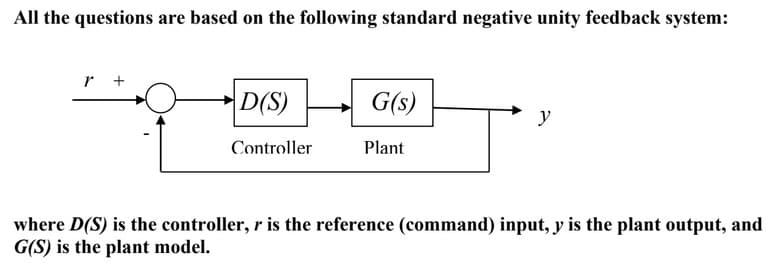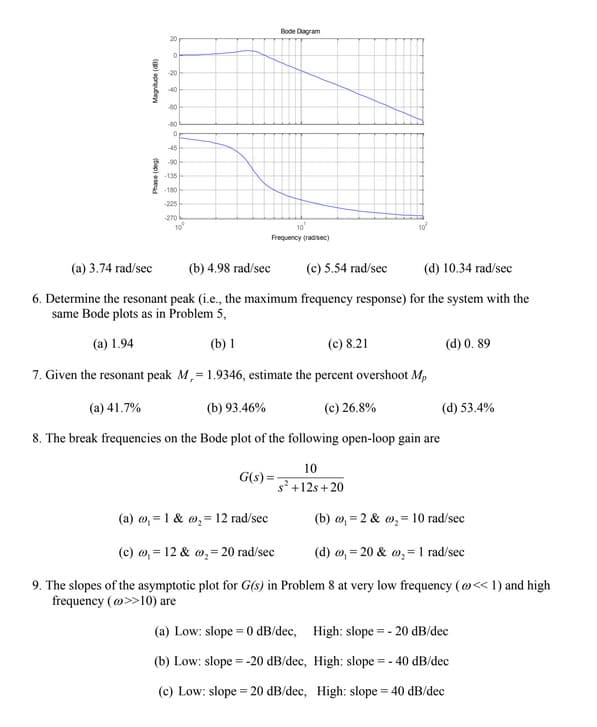Magnitude (dB) (ap) ad 40 --40 0 45 -90 -135 225 -270 (a) e,= 1 & (a) 3.74 rad/sec (b) 4.98 rad/sec (c) 5.54 rad/sec (d) 10.34 rad/sec 6. Determine the resonant peak (i.e., the maximum frequency response) for the system with the same Bode plots as in Problem 5, (a) 1.94 (b) 1 (c) 8.21 7. Given the resonant peak M,= 1.9346, estimate the percent overshoot Mp (a) 41.7% (b) 93.46% (c) 26.8% 8. The break frequencies on the Bode plot of the following open-loop gain are 10 S² +12s+20 (c) = 12 & = 12 rad/sec G(s)= ₂ = Bode Dagram Frequency (radise) 10 ₂ = 20 rad/sec (b) ₁ = 2 & ₂ = 10 rad/sec (d) , = 20 & ₂ = 1 rad/sec 9. The slopes of the asymptotic plot for G(s) in Problem 8 at very low frequency (<< 1) and high frequency (@>>10) are (a) Low: slope = 0 dB/dec, High: slope = -20 dB/dec (b) Low: slope = -20 dB/dec, High: slope = -40 dB/dec (c) Low: slope = 20 dB/dec, High: slope = 40 dB/dec (d) 0.89 (d) 53.4%
Magnitude (dB) (ap) ad 40 --40 0 45 -90 -135 225 -270 (a) e,= 1 & (a) 3.74 rad/sec (b) 4.98 rad/sec (c) 5.54 rad/sec (d) 10.34 rad/sec 6. Determine the resonant peak (i.e., the maximum frequency response) for the system with the same Bode plots as in Problem 5, (a) 1.94 (b) 1 (c) 8.21 7. Given the resonant peak M,= 1.9346, estimate the percent overshoot Mp (a) 41.7% (b) 93.46% (c) 26.8% 8. The break frequencies on the Bode plot of the following open-loop gain are 10 S² +12s+20 (c) = 12 & = 12 rad/sec G(s)= ₂ = Bode Dagram Frequency (radise) 10 ₂ = 20 rad/sec (b) ₁ = 2 & ₂ = 10 rad/sec (d) , = 20 & ₂ = 1 rad/sec 9. The slopes of the asymptotic plot for G(s) in Problem 8 at very low frequency (<< 1) and high frequency (@>>10) are (a) Low: slope = 0 dB/dec, High: slope = -20 dB/dec (b) Low: slope = -20 dB/dec, High: slope = -40 dB/dec (c) Low: slope = 20 dB/dec, High: slope = 40 dB/dec (d) 0.89 (d) 53.4%
Introductory Circuit Analysis (13th Edition)
13th Edition
ISBN:9780133923605
Author:Robert L. Boylestad
Publisher:Robert L. Boylestad
Chapter1: Introduction
Section: Chapter Questions
Problem 1P: Visit your local library (at school or home) and describe the extent to which it provides literature...
Related questions
Question
100%
Multiple Choice
5. Determine the Bandwidth for the system with the following Bode plots of the closed-loop
transfer function,
---
number 9: option (d) Low: slope = 0 dB/dec, High: slope = - 40 dB/dec

Transcribed Image Text:All the questions are based on the following standard negative unity feedback system:
r +
D(S)
Controller
G(s)
Plant
y
where D(S) is the controller, r is the reference (command) input, y is the plant output, and
G(S) is the plant model.

Transcribed Image Text:Magnitude (dB)
Phase (deg)
20
0
-20
40
-60
-80
0
-45
-90
-135
-180
-225
-270
TOⓇ
Bode Dagram
10
Frequency (rad/sec)
G(s) =
(a) 3.74 rad/sec
(b) 4.98 rad/sec
(c) 5.54 rad/sec
(d) 10.34 rad/sec
6. Determine the resonant peak (i.e., the maximum frequency response) for the system with the
same Bode plots as in Problem 5,
(a) 1.94
(b) 1
(c) 8.21
7. Given the resonant peak M,= 1.9346, estimate the percent overshoot Mp
(a) 41.7%
(b) 93.46%
(c) 26.8%
8. The break frequencies on the Bode plot of the following open-loop gain are
10
s²+12s+20
(d) 0.89
(a) Low: slope = 0 dB/dec,
(b) Low: slope = -20 dB/dec,
(c) Low: slope = 20 dB/dec,
(d) 53.4%
(a) w₁=1 & 0₂= = 12 rad/sec
(b) , 2 & ₂ = 10 rad/sec
(c) , 12 & ₂= 20 rad/sec
(d) ₁ = 20 & ₂ = 1 rad/sec
9. The slopes of the asymptotic plot for G(s) in Problem 8 at very low frequency (@<< 1) and high
frequency (>>10) are
High: slope = -20 dB/dec
High: slope = -40 dB/dec
High: slope = 40 dB/dec
Expert Solution
Step by step
Solved in 10 steps with 4 images

Knowledge Booster
Learn more about
Need a deep-dive on the concept behind this application? Look no further. Learn more about this topic, electrical-engineering and related others by exploring similar questions and additional content below.Recommended textbooks for you

Introductory Circuit Analysis (13th Edition)
Electrical Engineering
ISBN:
9780133923605
Author:
Robert L. Boylestad
Publisher:
PEARSON

Delmar's Standard Textbook Of Electricity
Electrical Engineering
ISBN:
9781337900348
Author:
Stephen L. Herman
Publisher:
Cengage Learning

Programmable Logic Controllers
Electrical Engineering
ISBN:
9780073373843
Author:
Frank D. Petruzella
Publisher:
McGraw-Hill Education

Introductory Circuit Analysis (13th Edition)
Electrical Engineering
ISBN:
9780133923605
Author:
Robert L. Boylestad
Publisher:
PEARSON

Delmar's Standard Textbook Of Electricity
Electrical Engineering
ISBN:
9781337900348
Author:
Stephen L. Herman
Publisher:
Cengage Learning

Programmable Logic Controllers
Electrical Engineering
ISBN:
9780073373843
Author:
Frank D. Petruzella
Publisher:
McGraw-Hill Education

Fundamentals of Electric Circuits
Electrical Engineering
ISBN:
9780078028229
Author:
Charles K Alexander, Matthew Sadiku
Publisher:
McGraw-Hill Education

Electric Circuits. (11th Edition)
Electrical Engineering
ISBN:
9780134746968
Author:
James W. Nilsson, Susan Riedel
Publisher:
PEARSON

Engineering Electromagnetics
Electrical Engineering
ISBN:
9780078028151
Author:
Hayt, William H. (william Hart), Jr, BUCK, John A.
Publisher:
Mcgraw-hill Education,